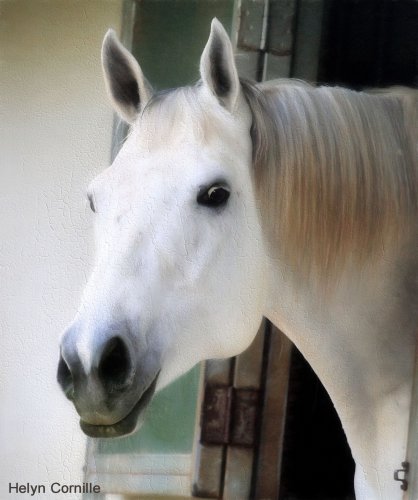Wisdom
Wisdom
“Knowledge is knowing what to say, wisdom is knowing whether or not to say it.”

“I saw the angel in the marble and carved until I set him free.” (Michelangelo) Our knowledge might free our horse’s full potential, but our wisdom is knowing that for a great part, the body coordination allowing the horse to express his talent results from the horse’s thoughts. Our sagaciousness is knowing when the horse needs our words and also, when our words should not disturb the horse mental processing.
Muscles and bones actively remodel in response to change in exercise. However, mechanoresponsiveness is actually a fundamental feature of all living tissues. Experiments with cultured cells confirm that mechanical stresses can directly alter many cellular processes, including signal transduction, gene expression, growth, differentiation, and survival. A great part of our education is creating situations challenging the horse’s mental processing and letting the horse explore the most efficient orchestration of his physique. This demands our knowledge; knowing the body coordination appropriate for the athletic demand of the performance, and the wisdom of letting the horse’s mental processing develop.
“Among the pitfalls of the human condition is our tendency to see otherness as a source of dread rather than an invitation to friendly curiosity.” (Laurel Braitman) In the face of the horse’s size and power, we have resorted to domination. We have developed riding techniques and training psychologies based on obedience and submission. We have gravely underestimated the horse’s willingness and intelligence, and we have succumbed to the dumbest form of leadership. Paraphrasing Henry Kissinger, instead of creating an alchemy of vision that moves the horse from where he was to a place that he never has been before, we have pretended that performances were the outcome of natural reflexes and left the horse unprepared for what we asked him to perform. In our delusion of exceptionalism, we have looked at the horse’s performance as a due and completely missed a partnership that would have moved our relation with equines and the ability of equines to perform, to a place that both, the horse and human have never been before.
The equestrian art is not about making the horse perform; the art is creating, in partnership with the horse, the athleticism allowing full and sound expression of the horse’s potential and beyond. At the best, the classical literature may have supported the horse’s potential but never went beyond. “The existence of discrete network within discrete networks in bones, cartilages, tendons and ligaments optimizes their structural efficiency as well as energy absorption.” (Christopher S. Chen and Donald E. Ingber. Tensegrity and mechanoregulation: from skeleton to cytoskeleton, 1999)Performances can be completed with solely the superficial systems. The horse’s full potential and beyond, demands a partnership guiding the horse’s mental processing to orchestrate the deeper systems. The horse does have the intelligence and the willingness to explore at the deepest level, but only with the help of an equitation respecting and developing his intelligence.
The dumb leadership of the natural horsemanship as well as the gross equitation of the correct aids, have not reached the level of consciousness that allows us to work with the horse’s intelligence. The horse has figured how to complete the many blanks of our equitation of the correct aids. Supported with greater understanding of the athleticism beyond each performance, the horse’s intelligence can be directed toward the subtle orchestration of the deepest systems. In the show ring, talented horses exhibit extravagant gaits, because they are bred to have extravagant gaits, but rarely with elegance. Edsger Dijkstra questions, "Why has elegance found so little following?" Because elegance demands precise orchestration of all the systems, from molecular to gross anatomy. The father of biotensegrity, Stephen Levin, describes how every part of an organism from molecular to the gross anatomy, is integrated by a mechanical system into a complete functional unit. The equestrian art is guiding the horse’s brain toward a superior functional physique.
Through the rehabilitation program of the Science of Motion, we saw very often an evolution going further than restoring soundness. The first aim, restoring soundness, often introduced the second aim, unraveling superior gaits. Identifying and correcting the source of the dysfunction that created the kinematics abnormality and consequent injury, allowed the horse to reach a place where he never has been before. The horse unraveled gaits unknown from his owner and performed movements that were previously out of his reach. The equitation of the correct aids caused the injury. The conversation guiding the horse’s brain toward functional use of his physique through subtle nuances in muscle tone and integrity of the rider’s body, restored soundness and unraveled the horse true potential.
“No amount of security is worth the suffering of a mediocre life chained to a routine that has killed your dream.” ( Maya Mendoza) Paraphrasing Albert Einstein, it demands courage and a touch of genius to look the other way, but Einstein also said that we are all born a genius but we are dumbed down by the system. Talking to the students of the Science of Motion at a higher level of consciousness and intelligence exposes that this level of greater intelligence is indeed, the riders’ comfort zone. Talking to the horse at a higher level of subtlety and intelligence demonstrates that such level of sophistication and intellect is indeed, the horse’s comfort zone. Jean Luc Cornille


 twitter
twitter facebook
facebook google
google pinterest
pinterest linkedin
linkedin